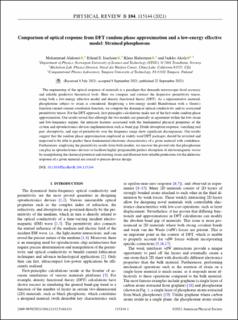| dc.contributor.author | Alidoust, Mohammad | |
| dc.contributor.author | Isachsen, Erlend E | |
| dc.contributor.author | Halterman, Klaus | |
| dc.contributor.author | Akola, Jaakko | |
| dc.date.accessioned | 2022-03-02T08:14:07Z | |
| dc.date.available | 2022-03-02T08:14:07Z | |
| dc.date.created | 2021-10-13T15:27:45Z | |
| dc.date.issued | 2021 | |
| dc.identifier.citation | Physical review B (PRB). 2021, 104 (11), . | en_US |
| dc.identifier.issn | 2469-9950 | |
| dc.identifier.uri | https://hdl.handle.net/11250/2982282 | |
| dc.description.abstract | The engineering of the optical response of materials is a paradigm that demands microscopic-level accuracy and reliable predictive theoretical tools. Here we compare and contrast the dispersive permittivity tensor, using both a low-energy effective model and density functional theory (DFT). As a representative material, phosphorene subject to strain is considered. Employing a low-energy model Hamiltonian with a Green's function current-current correlation function, we compute the dynamical optical conductivity and its associated permittivity tensor. For the DFT approach, first-principles calculations make use of the first-order random phase approximation. Our results reveal that although the two models are generally in agreement within the low-strain and low-frequency regime, the intricate features associated with the fundamental physical properties of the system and optoelectronics devices implementation such as band gap, Drude absorption response, vanishing real part, absorptivity, and sign of permittivity over the frequency range show significant discrepancies. Our results suggest that the random phase approximation employed in widely used DFT packages should be revisited and improved to be able to predict these fundamental electronic characteristics of a given material with confidence. Furthermore, employing the permittivity results from both models, we uncover the pivotal role that phosphorene can play in optoelectronics devices to facilitate highly programable perfect absorption of electromagnetic waves by manipulating the chemical potential and exerting strain and illustrate how reliable predictions for the dielectric response of a given material are crucial to precise device design. | en_US |
| dc.language.iso | eng | en_US |
| dc.publisher | American Physical Society | en_US |
| dc.relation.uri | https://journals.aps.org/prb/abstract/10.1103/PhysRevB.104.115144 | |
| dc.title | Comparison of optical response from DFT random phase approximation and a low-energy effective model: Strained phosphorene | en_US |
| dc.type | Peer reviewed | en_US |
| dc.type | Journal article | en_US |
| dc.description.version | publishedVersion | en_US |
| dc.rights.holder | © American Physical Society | en_US |
| dc.source.pagenumber | 13 | en_US |
| dc.source.volume | 104 | en_US |
| dc.source.journal | Physical review B (PRB) | en_US |
| dc.source.issue | 11 | en_US |
| dc.identifier.doi | 10.1103/PhysRevB.104.115144 | |
| dc.identifier.cristin | 1945654 | |
| cristin.ispublished | true | |
| cristin.fulltext | postprint | |
| cristin.qualitycode | 2 | |
